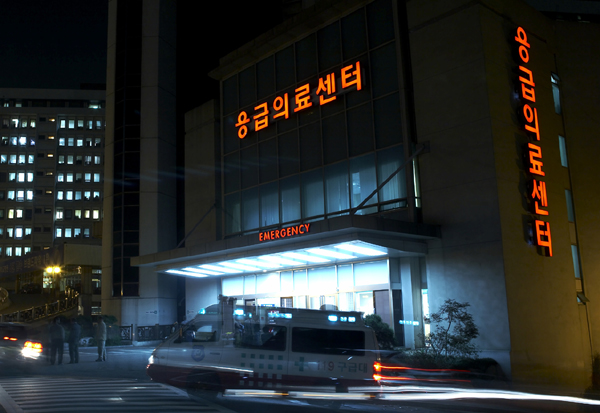The nation’s large general hospitals, severely affected by the Middle East Respiratory Syndrome (MERS) two years ago, have revamped their emergency centers to reduce the stay of patients and put infection risks under greater control.
The hospitals’ move came after the revision of the Emergency Medical Service Act, which forced hospitals to control the entering and exiting of patients and to minimize their time of stay, in the wake of the MERS outbreak.
Under the revised law, hospitals should limit the number of guardians to one or two per patient who can stay in an emergency room from Dec. 3. Also, they should restrict the proportion of patients -- who stay at the emergency room for more than 24 consecutive hours -- below 5 percent. From December next year, hospitals should categorize different acuteness levels for emergency patients and select outpatients suspected of contracting an infectious disease for more observation.
The quickest move came from Samsung Medical Center, which was directly hit by the MERS in 2015. In May last year, the hospital drastically revamped its emergency center. The space for the emergency center has been broadened to 1,874 square meters from 1,335㎡. The number of beds went up to 65 from 33. Before the use of the emergency room, all patients were required to visit “Fever and Respiratory Examination Division” where 11 negative pressure air-conditioned rooms were equipped with fully protected practitioners available for 24 hours.
As the revised law going into effect within a few months, other large hospitals are speeding up their moves to overhaul emergency rooms.

Severance Hospital세브란스병원 changed the structure of the emergency center to a square-shaped one. Adopted in Korea for the first time, the square-shaped emergency center allows medical staffs to notice the status of patients quickly and to respond accordingly. The emergency room’s space more than doubled to 3,300㎡ from 1,520㎡ and its air conditioning system prevents infectious air from spreading outside. Three separate entrances allow patients to separately enter the emergency room, according to the different status of patients – walking patients, patients carried on an ambulance and those with fever. Each treatment room has partitioning facilities in case of natural disasters such as flooding or fire.

Seoul National University Hospital서울대병원 focused more on improving the emergency medical service system. The hospital is annually picked by the Ministry of Health and Welfare as having the most overcrowded emergency room among Korean hospitals. To prevent the overcrowding from wasting precious time for urgent treatments, the hospital adopted a new system in September to have professors and other specialists directly seeing patients in the emergency room. Six doctors from internal medicine, surgery, neurosurgery, neurology and emergency medicine stay in the emergency room. SNUH said it is the first hospital where a professor other than an emergency medicine doctor resides in the emergency room.
Hallym University Chuncheon Sacred Heart Hospital revamped the emergency medical service system to allow physicians to directly examine emergency patients in August 2016. Later, the average waiting time at the hospital’s emergency room was reduced to 3.2 hours. As of 2016, the average waiting time at emergency rooms at all hospitals was 6.7 hours. For the first time in Korea, the hospital changed all beds of the emergency room to one bed per one emergency patient.
Seoul St. Mary’s Hospital took out the waiting room for guardians from the emergency center and put it outside. Instead, the hospital installed a monitor in the waiting room to help guardians follow the process of examination and treatment of the patients.

